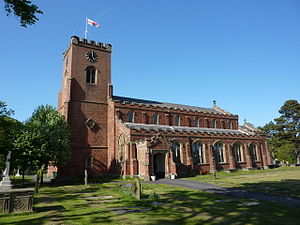- St Cuthbert's Church, Lytham
-
St Cuthbert's, Lytham 
Location in Lancashire Coordinates: 53°44′15″N 2°58′34″W / 53.7374°N 2.9762°W OS grid reference SD 3570227222 Location Lytham, Lancashire Denomination Anglican Architecture Status Parish church Functional status Active Heritage designation Grade II* Architect(s) W. H. Hobden
Paley and Austin
Austin and PaleyCompleted 1834–1835 Administration Deanery Kirkham Archdeaconry Lancaster Diocese Blackburn Province York St Cuthbert's is an Anglican church in Lytham, Lancashire, England. It was built 1834–1835, replacing a previous church on the same site. It is an active parish church in the Diocese of Blackburn. It has been designated a Grade II* listed building by English Heritage.
Contents
History
The current church is the third to be built on the site. A church was built in 1770, replacing an older structure of cobbles.[1] The 1770 building was in turn replaced by the current structure, built in 1834–1835 to a design by W. H. Hobden.[1][2] It was enlarged in 1872 by Paley and Austin, and in 1882 the same partnership added the north aisle.[3] The church was further enlarged in 1909.[4] A chapel was added in 1931 by Austin and Paley.[2] On 13 January 1971 the church was designated a Grade II* listed building by English Heritage.[4] The Grade II* designation—the second highest of the three grades— is for "particularly important buildings of more than special interest".[5]
St Cuthbert's is an active parish church in the Diocese of Blackburn, the Archdeaconry of Lancaster, and the Deanery of Kirkham.
Architecture
Exterior
St Cuthbert's is constructed of dark red brick with sandstone dressings in the Perpendicular style.[4] The roofs are slate. The plan consists of a west tower, a nave with aisles to the north and south, to the east, a chancel and a vestry north of the chancel.[1][4] There is a small porch at the west end of the south aisle.
The tower has diagonal buttresses and three stages.[4] Its parapet is crenellated.[2] It has two-light belfry louvres and a two-light west window. The aisles have three-light windows in the Perpendicular style and the nave clerestory has smaller two-light windows. There are two-light windows in the chancel and the east window is a large three-light window in the Arts and Crafts style.[4] Like the tower, the aisle, nave, porch and chancel walls are crenellated.[2]
Interior and fittings
The tower houses a ring of eight bells, hung in a wooden frame.[6] The church includes monuments to the local Clifton family.[1]
St Cuthbert's stained glass includes a window designed in 1860 by Hardman & Co., an 1874 window depicting the Mount of Olives by Morris & Co. as well as work by Charles Eamer Kempe, Jean-Baptiste Capronnier and Clayton and Bell.[2]
Churchyard and surroundings
Approximately 3 metres (9.8 ft) south-east of the church porch is a sandstone pedestal sundial, undated, but probably from the 18th century.[7] It has a gadrooned base with a fluted collar.[7] The plate and gnomon are coper and the plate is inscribed with "Dum spectes fugio".[1] The sundial has been given a Grade II designation from English Heritage.[7]
About 30 metres (98 ft) north of the church there is a monument to the crew of the St Annes-on-Sea lifeboat Laura Janet, who drowned in 1886 in an attempted rescue mission of the Mexico.[8] The monument is constructed of red sandstone and, 4 metres (13 ft) high, sits on a square plinth of two steps. It is carved with an image of the lifeboat and inscribed with the names of the lost crew members. The monument has also been given a Grade II designation.[8]
The vicarage to the west of St Chuthbert's may date from 1836, and may have been deisgned by W. H. Hobden.[2] It is constructed of red brick in Flemish bond with ashlar dressings in the Elizabethan style.[2] Some features are Jacobean.[9] The vicarage has been designated a Grade II listed building by English Heritage.[9]
See also
- List of ecclesiastical works by Paley and Austin
References
Footnotes
- ^ a b c d e Farrer & Brownbill (1929), pp. 213–19
- ^ a b c d e f g Hartwell & Pevsner (2009), p. 434
- ^ Price (1998), p. 84
- ^ a b c d e f "Church Of St Cuthbert", National Heritage List for England (English Heritage), http://list.english-heritage.org.uk/resultsingle.aspx?uid=1196361, retrieved 29 April 2011
- ^ "Listed Buildings", english-heritage.org.uk (English Heritage), http://www.english-heritage.org.uk/caring/listing/listed-buildings/, retrieved 22 April 2011
- ^ Cheetham (1919), pp 61–63
- ^ a b c "Sundial Approximately 3 Metres South East Of Porch Of Church Of St Cuthbert", National Heritage List for England (English Heritage), http://list.english-heritage.org.uk/resultsingle.aspx?uid=1196362, retrieved 29 April 2011
- ^ a b "Laura Janet Monument Approximately 30 Metres North Of Church Of St Cuthbert", National Heritage List for England (English Heritage), http://list.english-heritage.org.uk/resultsingle.aspx?uid=1297684, retrieved 29 April 2011
- ^ a b "Vicarage", National Heritage List for England (English Heritage), http://list.english-heritage.org.uk/resultsingle.aspx?uid=1196363, retrieved 29 April 2011
Sources
- Cheetham, F. H. (1919), The Church Bells of Lancashire [Part 4: The Hundred of Amounderness], Sherratt & Hughes, OCLC 27475286
- Farrer, William; Brownbill, J., eds. (1912), "Lytham", A History of the County of Lancaster: Volume 7, OCLC 59626695, http://www.british-history.ac.uk/report.aspx?compid=53221
- Hartwell, Clare; Pevsner, Nikolaus (2009) [1969], Lancashire: North, New Haven and London: Yale University Press, ISBN 0300126670
- Price, James (1998), Sharpe, Paley and Austin: A Lancaster Architectural Practice 1836–1942, Lancaster: Centre for North-West Regional Studies, ISBN 1-86220-054-8
External links
 Media related to St Cuthbert's Church, Lytham at Wikimedia Commons
Media related to St Cuthbert's Church, Lytham at Wikimedia Commons
Categories:- Buildings and structures in Fylde (borough)
- Church of England churches in Lancashire
- Diocese of Blackburn
- Grade II* listed buildings in Lancashire
- Grade II* listed churches
- Lytham St Annes
- Paley and Austin buildings
Wikimedia Foundation. 2010.


